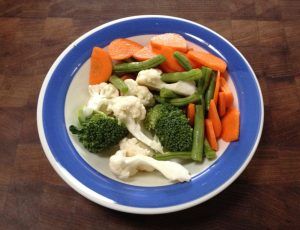Fragrant pumpkin curry is an ideal recipe to use spare vegetables. It is quick and easy to prepare and requires no added salt or fat (oil).
Serves 2
Ingredients
- 1½ cups of diced pumpkin
- 1½ cups mixed vegetables (see suggestions below)
- 400g cooked green or brown lentils (alternatives are borlotti or cannellini beans)
- 1 tablespoon grated fresh ginger
- 1 teaspoon ground turmeric
- ½ teaspoon ground cinnamon
- ½ teaspoon ground cumin
- 1 large star anise
Method for pumpkin curry
- Place diced pumpkin and spices in a 2 litre pot and just cover with boiled water. Stir in the spices well. Bring to the boil and simmer. Taste the curry and add more spices as required.
- Whilst the pumpkin is still firm add the mixed vegetables and lentils or beans. Stir the ingredients well. Bring the pumpkin curry back to a simmer. Top up the water level as required. Aim to keep the base of the pot covered by 1 to 2 cm of liquid.
- Cook the curry until vegetables are cooked but still firm.
- Serve with boiled rice.
Ideal vegetables
- Cauliflower
- Broccoli
- Zucchini
- Beans
- Asparagus
- Peas
- Snow peas
- Kale or spinach
Prepare the vegetables so they will have a similar cooking time in the pumpkin curry. Cut dense vegetables, such as cauliflower into smaller pieces, compared to beans and zucchini. Snow peas and spinach only need to be added to the pumpkin curry two minutes prior to the end of cooking.
Health benefits of pumpkin curry
Fragrant pumpkin curry has no added salt or fat and is high in fibre. It also provides a good range of antioxidants. It is a great meal for everyone in the family. Fragrant pumpkin curry is suitable for people with high blood pressure or cholesterol, diabetes and for those wanting to reduce body fat.
Eastern nutrition promotes the eating of meals that contain all the flavours and tastes. Pumpkin is a warm sweet food, which means it is highly nutritious and easy to digest. The classification of ‘sweet’ in Ayurveda and Traditional Chinese Medicine refers to a food that is very nutritious. In Western nutrition, sweet is used to describe sugary foods, which has a different meaning to that implied in Eastern nutrition. Lentils and legumes are nutritious staple foods. The spices provide additional health benefits through the qualities of the flavours and tastes in the meal:
- Fresh ginger is hot, pungent and sweet
- Turmeric is warm, bitter and pungent
- Cinnamon is hot, pungent and sweet
- Cumin is warm and pungent
- Star anise is warm, pungent and sweet
Ideally the meal would also contain the bitter flavour. This may be obtained from vegetables such as broccoli, asparagus and kale.
Fragrant pumpkin curry is a flavoursome meal that offers health benefits from both Eastern and Western nutrition perspectives.
Reference: Daverick Leggett, Helping Ourselves: A guide to Traditional Chinese Food Energetics, Meridian Press England 2008

